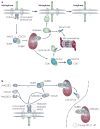Mitotic chromosomal instability and cancer: mouse modelling of the human disease
- PMID: 20094045
- PMCID: PMC5526619
- DOI: 10.1038/nrc2781
Mitotic chromosomal instability and cancer: mouse modelling of the human disease
Abstract
The stepwise progression from an early dysplastic lesion to full-blown metastatic malignancy is associated with increases in genomic instability. Mitotic chromosomal instability - the inability to faithfully segregate equal chromosome complements to two daughter cells during mitosis - is a widespread phenomenon in solid tumours that is thought to serve as the fuel for tumorigenic progression. How chromosome instability (CIN) arises in tumours and what consequences it has are still, however, hotly debated issues. Here we review the recent literature with an emphasis on models that recapitulate observations from human disease.
Conflict of interest statement
The authors declare no competing financial interests.
Figures


References
-
- Boveri T. Über mehrpolige mitosen als mittel zur analyse des zellkerns. Verh Phys Med Ges Würzburg. 1902;35:67–90.
-
- Boveri T. Zur Frage der Entstehung Maligner Tumoren. Gustav Fischer; Jena, Germany: 1914.
-
- Artandi SE, et al. Telomere dysfunction promotes non-reciprocal translocations and epithelial cancers in mice. Nature. 2000;406:641–645. - PubMed
-
- Garcia-Higuera I, et al. Genomic stability and tumour suppression by the APC/C cofactor Cdh1. Nature Cell Biol. 2008;10:802–811. - PubMed
Publication types
MeSH terms
Grants and funding
LinkOut - more resources
Full Text Sources
Other Literature Sources
Molecular Biology Databases

